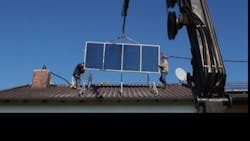Fights Over Net Metering for Rooftop Solar Reflect the Evolution of an Opportunity
The money side of the expansion of distributed generation systems — for instance, how building owners with rooftop solar panels pay for the systems and how much they are compensated for the power they provide the grid, as well as how the utility funds construction and maintenance and upgrades to the system to allow two-way flow of power — leads to some of the key questions about the growth of distributed generation. The answers vary from state to state and from utility to utility, and in the midst of several highly politicized legislative and regulatory battles, they can change from month to month. But the eventual shape of those answers will do a lot to determine where and how quickly distributed generation will make its impact felt in the electrical industry.
Legislation and debates over utility net-metering policies for compensating owners of distributed power systems such as rooftop solar who want to sell their excess power back onto the grid continue to play out for and against the growth of distributed generation.
It’s very much a state-by-state story. Indiana legislators last month introduced a bill to slash net metering credits and add fixed charges to the bills of customers with rooftop solar systems. In Montana, a state Senate bill that would have expanded net metering was killed in committee.
An alliance of free-market and environmental groups in Florida are pushing a 2016 ballot initiative allowing property owners who generate solar power to sell the electricity directly to other customers.
In Massachusetts, legislation has been proposed to increase the state’s net metering caps by 2% in the public sector and 1% in the private sector to support solar development. The bills also extend the deadline for a task force to develop a long-term plan to encourage solar growth in the state.
In New York, Governor Cuomo announced a $5 billion Clean Energy Fund and efforts to establish a new community net metering program that would expand solar access to renters and others who can’t put solar on their own homes or businesses. The governor’s new proposed budget would further increase support for solar through a sales tax exemption on solar power purchase agreements (PPAs), making third-party financing options more attractive.
A cover story in the current edition of Electrical Wholesaling looks at the changing options for funding distributed generation systems. Electrical distributors, manufacturers and reps need to pay attention to how these battles play out in their local markets, because the outcome could shape demand for electrical products as new options for distributed generation systems emerge. Keep an eye on changes in policies regarding federal and state incentives, utility net-metering, interconnection and access to capital.
At this point, policies regarding distributed generation primarily apply to rooftop solar systems, but similar concerns accompany efforts to build markets for other distributed generation systems using everything from small-scale wind turbines and fuel cells to campus- or neighborhood-sized microgrids.
The most recent battles over setting rates and tariffs for connecting small-scale solar power to the electrical grid are playing out in a setting that is extremely contentious and inevitably turns on local politics and balances of power. Therefore, drawing hard conclusions on a national scale will be difficult for a time, but it’s not too soon to see how the various possible outcomes might affect the market for residential and commercial power systems.
A study by GreenTechMedia’s research group estimates that best-in-class residential solar systems will be installed for less than $3 per watt this year. Average systems, still estimated below $3.50 per watt, cost more because of higher costs in labor and supply-chain management.
Federal and state incentives, most in the form of tax credits and rebates, provide a base incentive to help offset the cost of a solar system. The cornerstone of these incentives has been the federal government’s solar investment tax credit (ITC), a 30% tax credit for solar systems on residential and commercial properties. It was implemented in 2006 and extended in 2008. Unless given another extension, it now expires in 2016.
According to the Solar Energy Industries Association (SEIA), the ITC has helped annual solar installations grow by over 1,600% since its inception (a compound annual growth rate of 76%), and has provided market certainty for companies to make the kinds of long-term investments that drive competition and technological innovation, which in turn lowers costs for consumers.
State incentives vary widely, and this is where major changes are being debated now. According to the latest data available from DSIRE (Database of State Incentives for Renewables and Efficiency), a goldmine of data operated by the N.C. Clean Energy Technology Center at North Carolina State University, 43 states and the District of Columbia have adopted statewide net-metering policies, 41 states have loan programs for renewables, at least 24 states have policies authorizing solar power purchase agreements, 38 states have property tax incentives for renewable power systems, 24 states offer tax credits for renewables, and 16 states have rebate programs. (Go to www.dsireusa.org to explore this further.)
The past few years have also seen a flourishing of options for paying for a rooftop solar system. For many years, PPAs offered by companies such as SolarCity received the warmest reception among those who wanted a solar system on their homes. But signs exist that PPAs are declining in popularity as more home owners prefer to own the systems outright.
